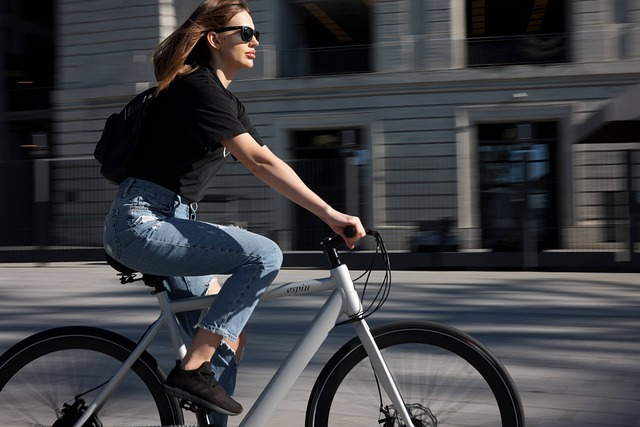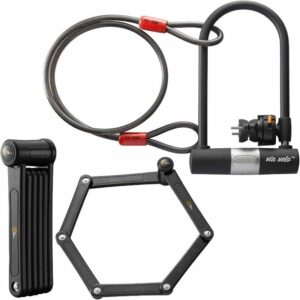Are Electric Bikes Safe? Navigating the Landscape of E-Bike Safety – Part 1
Key Takeaways
Key Takeaways from Part 1:
-
Electric bikes (e-bikes) blend innovation with tradition, integrating electric motors while retaining the bicycle’s familiar form.
-
E-bikes are not inherently dangerous, and risks associated with them can be managed through responsible riding, adherence to traffic rules, and informed decision-making.
-
Myths surrounding e-bike safety, including concerns about battery fires and uncontrollable acceleration, can be dispelled by understanding advancements in technology.
-
Proper throttle application and effective braking systems mitigate the risk of sudden acceleration, a concern shared by various vehicles, including cars.
-
Comparing e-bikes with traditional bicycles reveals that challenges associated with higher speeds and collisions are not unique to e-bikes.
-
The safety of e-bike batteries, particularly lithium-ion batteries, is assured through advancements in technology and proper maintenance practices.
-
Adhering to traffic rules, using proper lighting, signaling intentions, and sharing the road responsibly are essential for safe e-bike riding.
-
Personal safety measures, such as wearing helmets, using reflective gear, and employing hand signals, significantly reduce risks for e-bike riders.
-
Proper training enhances safety by educating new e-bike users about throttle applications, braking distances, and unique e-bike features.
-
Part 1 emphasizes that e-bike safety relies on awareness, education, responsible usage, and the adoption of practical measures for risk reduction.

Key Takeaways from Part 2:
- Maintenance Matters: Regular maintenance keeps your e-bike running smoothly and minimizes safety risks. Regularly inspect brakes, tires, and lights, and address issues promptly.
- Battery Care: Properly manage and care for your e-bike’s battery. Follow manufacturer guidelines for charging and storage to ensure longevity and safe operation.
- Proper Training: New e-bike users benefit from proper training that covers throttle application, braking, and other unique features. Education enhances responsible riding.
- Safety Gear: Helmets, visibility-enhancing gear, and proper clothing are integral to personal safety. Wearing them makes you more visible and communicates your intentions to others.
- Adhering to Traffic Rules: Treat your e-bike like any other vehicle on the road. Adhere to traffic rules, signals, and signs to ensure the safety of all road users.
- Responsible Riding: Understanding your e-bike’s dynamics and limitations is crucial for responsible riding. Be mindful of throttle application, braking distances, and handling, especially at higher speeds.
- Environmental Impact: E-bikes offer eco-friendly transportation, reducing carbon emissions and traffic congestion. Responsible usage amplifies their positive environmental contributions.
- Awareness and Communication: Stay aware of your surroundings and communicate your intentions to other road users. Effective signaling and cautious riding prevent accidents.
- Safety Culture: Promote a safety-conscious culture among e-bike users. Encourage education, proper gear usage, and responsible riding practices within the e-bike community.
- Ongoing Learning: The world of e-bikes is evolving. Stay informed about new technologies, safety features, and riding techniques to enhance your e-bike experience.
Setting the Wheels in Motion: A Deep Dive into E-Bike Safety
As the popularity of electric bikes (e-bikes) continues to surge, so do questions about their safety. Are electric bikes safe? This question reverberates through the minds of potential riders and concerned citizens alike. In this comprehensive exploration, presented in two parts, we delve into the intricacies of e-bike safety, dissecting the risks, dispelling myths, and shedding light on the measures that make e-bikes a secure mode of transportation.

Part 1 of our journey takes us through the realms of e-bike safety on the road. We begin by understanding the fusion of innovation and tradition that defines e-bikes, exploring how these vehicles integrate technological advancements while retaining the familiar form of a bicycle. We then dive into the heart of the matter: Are e-bikes dangerous? We address this pressing concern, acknowledging the associated risks while highlighting the avenues to mitigate them effectively. Furthermore, we dispel common myths surrounding e-bike safety, uncovering the truth behind these misconceptions.
Understanding throttle application’s delicate balance and comparing e-bikes with traditional bicycles forms the subsequent phase of our exploration. We delve into the battery factor, clarifying the safety concerns associated with lithium-ion batteries and how advancements in technology are addressing these issues. Additionally, we emphasize the importance of adhering to traffic rules and exercising road awareness while sharing the road with other vehicles and pedestrians.
Our journey concludes in this part by focusing on personal safety measures. We underline the significance of wearing helmets, enhancing visibility through proper lighting and reflective gear, and employing hand signals to communicate intentions effectively. Finally, we stress the value of proper training for new e-bike users, empowering riders with the knowledge needed to navigate e-bike dynamics responsibly.
As we conclude Part 1, the importance of informed riding and a safety-conscious approach becomes evident. Join us in Part 2 as we delve deeper into the realm of e-bike ownership, where maintenance takes center stage. Just as responsible riding plays a pivotal role in ensuring safety, maintaining your e-bike is crucial for a smooth and secure riding experience.
E-Bikes: A Fusion of Innovation and Tradition
E-bikes, at their core, represent a harmonious blend of innovation and tradition. Within their frames, these vehicles encapsulate the timeless form of the bicycle while seamlessly integrating cutting-edge electric propulsion systems. This fusion results in a transformative paradigm shift in urban mobility and requires a nuanced consideration of safety aspects.
Honoring the Bicycle’s Legacy
The design philosophy of e-bikes pays homage to the enduring legacy of the conventional bicycle, an invention that has transcended generations. The familiar arrangement of two wheels, pedals, handlebars, and the characteristic geometry remains unchanged. Yet, concealed beneath this recognizable exterior is the technological heart of the e-bike – the electric motor.
The Intersection of Human and Machine
Central to the e-bike experience is the interaction between the rider and the motor. Some e-bike models necessitate pedaling for the motor to engage, seamlessly blending the rider’s physical effort with electric assistance. This mode mirrors the essence of traditional cycling, where human exertion synergizes with technological enhancement, resulting in a ride that’s both dynamic and energy-efficient.
Throttle-Powered Propulsion
Conversely, another segment of e-bikes is equipped with throttle-based propulsion systems. These models allow riders to activate the motor through a throttle mechanism, similar to how a motorcycle accelerates. This approach eases urban navigation, making short distances manageable without extensive pedaling.
motorcycle accelerates. This approach eases urban navigation, making short distances manageable without extensive pedaling.
Navigating Safety Dynamics
The variations in e-bike modes give rise to unique safety dynamics. The interplay between pedaling and motor assistance creates distinct scenarios in terms of control, balance, and acceleration. Additionally, the choice between pedal-assist and throttle-powered models alters the emphasis on user interaction and control mechanisms.
In the upcoming sections, we will delve into the safety considerations of both pedal-assist and throttle-powered e-bikes. Through a data-driven exploration, we will address concerns, debunk myths, and provide insights that empower riders to make informed decisions. By comprehending the nuanced interaction between innovation and tradition, we navigate the e-bike safety landscape with a balanced perspective. Our aim is to ensure that the thrill of riding is coupled with responsible and secure practices, fostering a harmonious coexistence between humans and machines.
The Big Question: Are Electric Bikes Dangerous?
The growing popularity of electric bikes (e-bikes) inevitably raises a critical question: Are electric bikes dangerous? The short answer is that, like any mode of transportation, e-bikes come with their own set of risks. However, it’s essential to approach this question with a balanced perspective that considers both the potential dangers and the measures that can mitigate them.
Understanding Risk in Transportation
Before delving into the specifics of e-bike safety, it’s important to acknowledge that risk is an inherent aspect of any form of transportation. Whether you’re driving a car, riding a bicycle, or walking, there’s always a degree of risk involved. The key lies in understanding and managing these risks to ensure safe travel.
Navigating E-Bike Safety
When it comes to e-bikes, safety concerns often revolve around factors such as speed, control, and interaction with other road users. It’s crucial to recognize that these concerns aren’t unique to e-bikes; they also apply to traditional bicycles, motorcycles, and even cars. What distinguishes e-bikes is the fusion of human power and electric propulsion, which can influence how these risks manifest.
Mitigating Risks through Knowledge and Responsibility
The pivotal factor in addressing e-bike safety lies in knowledge and responsibility. Riders must be aware of the capabilities and limitations of their e-bikes. This includes understanding how the

motor functions, how acceleration occurs, and how to maintain control, especially at higher speeds.
Furthermore, e-bike riders should be well-versed in traffic rules and regulations. Just like any other road user, e-bike riders must adhere to speed limits, follow traffic signals, and yield to pedestrians. In many jurisdictions, e-bikes are subject to the same rules as bicycles, which emphasizes the importance of responsible riding.
Choosing the Right E-Bike
Selecting the appropriate e-bike model also plays a significant role in safety. Riders should consider factors such as their own skill level, the type of terrain they will be navigating, and their intended usage. For instance, if a rider is new to e-bikes, starting with a pedal-assist model might be a more gradual introduction to electric propulsion.
In the upcoming sections, we will delve deeper into specific safety considerations related to both pedal-assist and throttle-powered e-bikes. By examining data, studies, and real-world scenarios, we aim to provide a comprehensive overview that equips riders with the knowledge they need to make informed decisions. The objective is not to discourage e-bike usage, but rather to empower riders to enjoy the benefits of e-bikes while minimizing risks through education and responsible practices. Ultimately, the journey toward e-bike safety is one that involves collective efforts, awareness, and a commitment to sharing the road responsibly.
Dispelling Myths: E-Bikes and Safety
The landscape of electric bikes (e-bikes) has been clouded by myths and misconceptions, many of which center around safety concerns. As e-bikes continue to gain popularity, it’s imperative to dispel these myths and provide a clearer understanding of the safety landscape associated with these innovative vehicles.
Myth 1: Highly Combustible Batteries
One common misconception about e-bikes is the fear that their lithium-ion batteries are highly combustible, leading to potential explosions. While it’s true that lithium-ion batteries can pose risks if mishandled or damaged, the same can be said for any battery-powered device, including smartphones and laptops. In reality, e-bike batteries are designed with advanced battery management systems that regulate charging and discharging, reducing the risk of overheating and ensuring safe operation.
Myth 2: Uncontrollable Acceleration
Another myth that has circulated is the notion of e-bikes suddenly accelerating to dangerous speeds, putting riders at risk of losing control. This fear is often rooted in misconceptions about throttle-powered e-bikes. In truth, e-bikes are equipped with throttles that function similarly to those found on motorcycles or scooters. However, the amount of acceleration is controlled by the rider’s input and can be managed by using the throttle responsibly. Like any vehicle, e-bikes require riders to exercise caution and moderation.
Advancements in Safety Technology
One of the most important factors to consider is the technological advancements that have been integrated into modern e-bike designs. From improved battery management systems to sophisticated braking mechanisms, e-bikes are equipped with features that prioritize rider safety. For instance, some e-bikes include regenerative braking systems that recharge the battery while simultaneously providing controlled deceleration.
Education and Rider Responsibility
Perhaps the most effective way to dispel these myths is through education and rider responsibility. Just as operating a car requires understanding its functions and adhering to traffic rules, the same applies to e-bikes. Riders should familiarize themselves with their e-bike’s specific features, practice riding in controlled environments before venturing onto busy streets, and always follow local traffic regulations.
A Call for Responsible Reporting
Misinformation can perpetuate myths and fuel unnecessary fears. As the e-bike market continues to expand, it’s essential for media outlets and individuals to report accurately and responsibly on e-bike-related incidents. An isolated incident should not be used to cast a shadow over the entire e-bike community. Instead, a balanced perspective that acknowledges the benefits, challenges, and safety measures associated with e-bikes is crucial for fostering informed discussions.
In the following sections, we will delve into specific safety considerations related to both pedal-assist and throttle-powered e-bikes. By addressing these myths and shedding light on the reality of e-bike safety, we aim to equip riders with the knowledge they need to confidently and responsibly navigate the world of e-bike riding.
Understanding Throttle Application: A Delicate Balance
In the realm of e-bike safety, one of the most debated topics is the proper application of throttles. Throttle-controlled e-bikes have come under scrutiny due to concerns about sudden acceleration. However, it’s important to recognize that throttle-related issues are not unique to e-bikes; they can occur with any vehicle that utilizes a throttle-based propulsion system. Cars, motorcycles, and even scooters can experience acceleration challenges if not operated responsibly.
The Role of Throttle in E-Bikes
Throttle-based e-bikes operate similarly to vehicles with gas pedals. When the throttle is engaged, power is sent to the motor, propelling the e-bike forward. While this design offers convenience and ease of use, it also demands responsible rider behavior. Just as pressing the gas pedal in a car causes acceleration, applying the throttle on an e-bike can lead to an increase in speed.
Mitigating the Risk: Braking and Rider Control
The key to safe e-bike operation lies in the rider’s ability to manage throttle application and control speed. Most modern e-bikes are equipped with advanced braking systems that allow riders to slow down or come to a complete stop quickly. These braking mechanisms work in conjunction with the throttle to provide a balanced and controlled riding experience.

Additionally, responsible rider behavior is fundamental. Riders should be cautious when applying the throttle, especially in situations that require precise speed control, such as navigating through crowded areas, intersections, or tight spaces. A gradual and controlled approach to throttle use reduces the risk of sudden acceleration and enhances overall riding safety.
Learning from the Automotive Industry
The phenomenon of sudden acceleration is not exclusive to e-bikes. In the automotive industry, similar issues have been addressed through advancements in vehicle design, driver education, and safety technology. E-bike manufacturers have taken a similar approach by integrating safety features such as motor cutoff switches that disable the motor when the brakes are engaged. This feature provides riders with an immediate means to stop acceleration in emergency situations.
Rider Education and Skill Development
As e-bikes become more prevalent, rider education becomes paramount. New e-bike riders should take the time to learn about their e-bike’s throttle system and practice controlling speed in a safe environment. Riders with experience in throttle-controlled vehicles like motorcycles or scooters may have an advantage in understanding throttle dynamics.
Promoting Safety Through Responsible Riding
Ultimately, the safety of throttle-controlled e-bikes rests on the shoulders of riders. By respecting the power of the throttle, using it judiciously, and exercising caution in situations that demand precise speed control, riders can contribute to a safer e-bike environment. As e-bike technology evolves and safety features become more sophisticated, riders can enjoy the benefits of throttle-based propulsion while prioritizing safety at all times.
In the subsequent sections, we will further explore safety considerations specific to throttle-controlled e-bikes, including factors that contribute to sudden acceleration and strategies to prevent such occurrences. Through understanding and responsible application, riders can confidently harness the convenience of throttle-controlled e-bikes while ensuring a secure and enjoyable riding experience.
Comparing E-Bikes with Traditional Bikes
When it comes to e-bike safety, a valuable perspective emerges from comparing e-bikes to their traditional counterparts. While concerns about e-bikes’ higher speeds and associated risks are valid, it’s important to recognize that these risks are not exclusive to e-bikes. Traditional bike riders also face similar challenges when operating at higher speeds. By examining these dynamics, we can better understand the safety landscape and take proactive measures to enhance safety for all riders.
The Shared Challenge of Higher Speeds
One of the primary concerns in the e-bike safety discourse is the potential for accidents or collisions when riding at higher speeds. E-bikes, with their electric assistance, can achieve speeds that are faster than what traditional bicycles can reach through pedal power alone. This increased speed can lead to challenges in maneuvering, braking, and anticipating obstacles, especially in crowded or unpredictable environments.
However, the concept of speed-related risks is not unique to e-bikes. Traditional bike riders also experience similar challenges when they reach higher speeds, particularly when descending hills or riding on steep terrain. The increased momentum can make it harder to control the bike, necessitating quick reflexes and advanced braking techniques.
Navigating the Challenges
The shared challenge of managing higher speeds underscores the importance of responsible riding behavior for all cyclists, regardless of the type of bike they’re using. Here are some key considerations:
1. Skill and Experience:
Both e-bike and traditional bike riders should prioritize developing the necessary skills to handle higher speeds. This includes mastering braking techniques, maintaining proper control over the bike, and anticipating potential hazards.
2. Awareness and Anticipation:
Riders of all bikes should remain vigilant and anticipate changes in road conditions, traffic patterns, and the behavior of pedestrians and other cyclists. Staying aware of one’s surroundings is a critical aspect of preventing accidents.
3. Speed Management:
E-bike riders, in particular, should exercise caution when using higher levels of electric assistance, especially in situations that demand precise control. Gradual acceleration and deceleration can help prevent sudden changes in speed that might lead to loss of control.
4. Braking Techniques:
Both e-bike and traditional bike riders should hone their braking techniques, as effective braking is essential for managing speed and maintaining control. Riders should avoid abrupt or harsh braking, which can result in skidding and loss of balance.
A Call for Education and Awareness
The safety considerations linked to higher speeds underscore the importance of rider education and awareness campaigns. New e-bike riders, in particular, should undergo proper training that addresses the challenges of riding at various speeds. Additionally, public awareness campaigns can promote responsible behavior and highlight the shared risks faced by all cyclists when navigating higher speeds.
Navigating the Path Forward
As e-bikes become a more integral part of urban transportation, it’s crucial to approach speed-related risks with a comprehensive perspective. By recognizing that these risks are not unique to e-bikes and that they are inherent to cycling at higher speeds, we can collectively work toward enhancing safety. Responsible riding behavior, skill development, and a commitment to public safety can pave the way for a secure and harmonious coexistence of e-bikes and traditional bikes on the streets.
In the subsequent sections, we will delve into further safety considerations that e-bike riders should keep in mind, including the significance of adhering to traffic rules and the role of protective gear in ensuring rider safety. Through a holistic approach to safety awareness, we can foster a cycling environment that benefits riders of all types of bicycles.
Bike Safety, concluding Part 1
In Part 1 of our exploration, we embarked on a journey through the landscape of e-bike safety, unraveling the intricate web of concerns, dispelling myths, and understanding the nuances that contribute to secure e-bike riding. We learned that e-bikes, while not immune to risks, can be ridden safely through proper training, adherence to traffic rules, and responsible behavior.
As we transition into Part 2, we delve deeper into the realm of e-bike ownership, where maintenance takes center stage. Just as responsible riding plays a pivotal role in ensuring safety, maintaining your e-bike is crucial for a smooth and secure riding experience. In this segment, we will guide you through the essential steps to safeguard your e-bike’s performance, extend its longevity, and make each journey a seamless adventure.
So, join us in Part 2 as we venture into the world of e-bike maintenance—a territory where a little care can go a long way in enhancing your riding pleasure and ensuring that your e-bike remains a trusted companion for countless rides to come.






